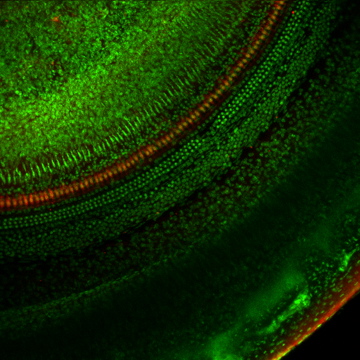Welcome
Our research uses a wide variety of methods and numerous preparations to better understand development, plasticity, pathology and potential repair of the inner ear and auditory pathways of the brain. We investigate both the fundamental neurobiology of hearing and translational opportunities of the present and future that are directed toward preventing and treating hearing loss and balance disorders.
One research program endeavors to understand cellular processes underlying development of information processing in the auditory system. Anatomical, physiological, and acoustical methods are used to examine development of cellular mechanisms underlying acoustic signal processing by the inner ear. Parallel studies use in vivo and in vitro preparations to examine the cellular biology underlying structural and functional development of the brain stem auditory pathways.
A second research program addresses the problem of how experience influences brain development. Using manipulations of the amount and pattern of neuronal activity impinging on neurons in the brain stem auditory system of birds and mammals, we study the cellular nature of signals that influence the growth, remodeling, and maintenance of neuronal and glial elements.
A third research program studies the cellular and molecular events responsible for inner ear hair cell death due to ototoxic drugs and aging. In vivo and in vitro preparations of inner ear sensory epithelium are used to study death and cell survival pathways. The zebrafish lateral line system allows high resolution imaging of the intracellular events required for hair cell death or survival, and a unique zebrafish genetic and drug screening screening assay is used to discover genes and new drugs that modulate these pathways and alter the susceptibility of hair cells to ototoxic drugs. Resulting drugs and genes are then tested in laboratory mammals. One drug developed through this program is in the late stages of development for clinical trials.
The final research program stems from the discovery that birds can regenerate inner ear receptor cells (hair cells) following noise- or drug-induced hearing loss. Ongoing studies include a worldwide consortium of leading laboratories aimed at determining the cellular and molecular events responsible for initiating hair cell regeneration and using this information to develop new therapies.
Rubelab
University of Washington
Box 357923
Seattle, Washington 98195-7923
Phone: (206) 543-8360
Fax: (206) 616-1828
E-mail: rubelab@u.washington.edu
Copyright 1999 University of Washington. All rights reserved.

